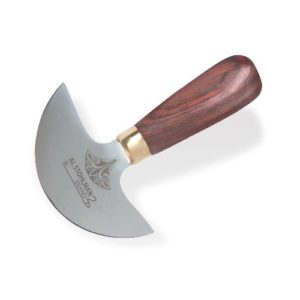
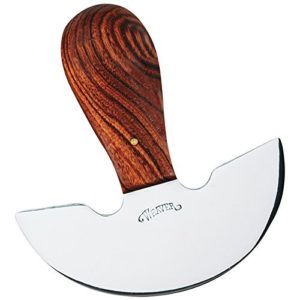
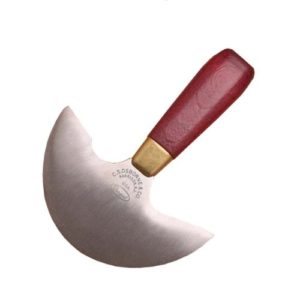
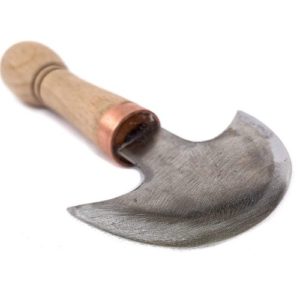
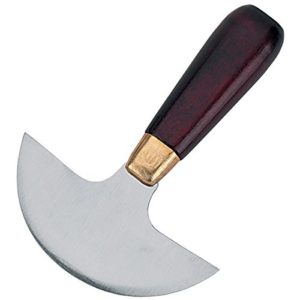
The round knife is a round-shaped blade on a rough wooden handle. Such a knife is typically used for the cutting of heavy leather, simple forms, straight and curved cuts, etc. It is sometimes referred to as a head knife and sold under such a title.
The round knife is indeed one of the most flexible weapons for dealing with leather. It consists of a broad, 1/2-circle blade on the rounded portion that is sharp. Because it has such a broad blade surface and cutting point, thicker leather can be sliced more easily than smaller blades.
For thin leathers and thorough cutting, such head knives often work well. The maneuverability of the tip of the blade allows it helpful for curves to be sliced. To set lines through the leather without completely cutting through, the blade depth may also be manually adjusted. It’s typically a round knife when someone is speaking about the quintessential leather knife.
If you are interested in buying high-quality round knives for leather, check the following top, comparison table and buying guide. Surely, the experts are interested in your feedback as well to find the best round knives in the U.S. market.
Tandy Leather Round Knife– the best for design!
 The Tandy Leather round knife is a powerful method for leather thinning (scrubbing) to cut sections of the substance. This premium cutter has been especially effective in terms of quality, style, comfort and value for money.
The Tandy Leather round knife is a powerful method for leather thinning (scrubbing) to cut sections of the substance. This premium cutter has been especially effective in terms of quality, style, comfort and value for money.
The Tandy leather knife has a stainless steel tip. The blade has a glass-like finish that helps the consumer to slither across dense leather or skin. The gun, with a lovely engraving on it, measures 4-3/8 inches.
The Tandy Leather round knife handle is constructed of hardwood, ergonomically curved to give you the highest, quickest and safest grip. You have a full advantage and can operate quicker with Tandy leather knives.
Pros
- Great build;
- Portable and lightweight;
- Durable blade;
- Comfortable grip;
- Good for scribbling and cutting leather;
- Clean cuts;
- Easy to sharpen;
- Budget-friendly;
Cons
- Bad for people with big hands;
- Cheap handle;
This leathercraft knife is designed for practitioners, but for beginners it is also appropriate. The key aim of this instrument is to use pockets, flaps, straps, etc. for cutting sections or parts of the leather project. As long as you have learned skiving with a round knife, it’s also the perfect weapon for all forms of skiving leather.
Weaver Leather Supply Hardwood Handle Round Knife– the best for staying sharp!
 The Weaver Leather Round Knife is a US-made product and it has some pretty excellent consumer feedback as one of their well-known high-quality products. The round knife blade of the weaver leather is hand-forged steel and it’s extra sharp as a result and remains sharp for a very long time.
The Weaver Leather Round Knife is a US-made product and it has some pretty excellent consumer feedback as one of their well-known high-quality products. The round knife blade of the weaver leather is hand-forged steel and it’s extra sharp as a result and remains sharp for a very long time.
It measures a shade over 4 inches high and approximately 5 inches long from one heel or pointed end of the blade to the other. Around 1/16 inches is the diameter of the tip.
The blade is sharpened and smoothly finished to allow leather cutting. Right from the box, everything is ready to use.
The handle of the round leather weaver knife is 1 3/64 inches wide and 3.5 inches long at the heel. It is constructed of hardwood that looks secure in your hands and durable.
This is a fantastic technical round knife and perfect for beginners who want leatherwork consistency right from the get-go.
Pros
- The US-made leather knife;
- Hand-forged steel for the blade;
- Very sharp and stays sharp for a long time;
- Easy to sharpen with strops;
- Cuts easily through natural and thick leather;
Cons
- A bit flexible;
- Not fully rust-resistant;
- Expensive;
If you wish to provide leatherwork as a long career or hobby, this Weaver leather round knife is a must-have product and you are able to spend slightly more on premium leatherwork equipment.
Weaver Leather Supply Hardwood Handle Round Knife– the best for staying sharp!
 The Weaver Leather Round Knife is a US-made product and it has some pretty excellent consumer feedback as one of their well-known high-quality products. The round knife blade of the weaver leather is hand-forged steel and it’s extra sharp as a result and remains sharp for a very long time.
The Weaver Leather Round Knife is a US-made product and it has some pretty excellent consumer feedback as one of their well-known high-quality products. The round knife blade of the weaver leather is hand-forged steel and it’s extra sharp as a result and remains sharp for a very long time.
It measures a shade over 4 inches high and approximately 5 inches long from one heel or pointed end of the blade to the other. Around 1/16 inches is the diameter of the tip.
The blade is sharpened and smoothly finished to allow leather cutting. Right from the box, everything is ready to use.
The handle of the round leather weaver knife is 1 3/64 inches wide and 3.5 inches long at the heel. It is constructed of hardwood that looks secure in your hands and durable.
This is a fantastic technical round knife and perfect for beginners who want leatherwork consistency right from the get-go.
Pros
- The US-made leather knife;
- Hand-forged steel for the blade;
- Very sharp and stays sharp for a long time;
- Easy to sharpen with strops;
- Cuts easily through natural and thick leather;
Cons
- A bit flexible;
- Not fully rust-resistant;
- Expensive;
If you wish to provide leatherwork as a long career or hobby, this Weaver leather round knife is a must-have product and you are able to spend slightly more on premium leatherwork equipment.
C. S. Osborne No. 70 Round Knife – the best for the handle!
 Including a trusted collection of premium equipment for leatherwork, C.S. Osborne, now owned by the Osborne family’s seventh generation, also retains its old-age quality levels that are visible in any instrument manufactured in the US.
Including a trusted collection of premium equipment for leatherwork, C.S. Osborne, now owned by the Osborne family’s seventh generation, also retains its old-age quality levels that are visible in any instrument manufactured in the US.
Their C.S Osborne No. 70 round knife is one of the high-quality instruments they have made and loved through the years because of its tremendous popularity as a staple tool for most leather crafters.
The C’s blade. The 1075 high carbon steel S. Osborne No.70 head knife is designed to offer you the best of the best in terms of precise cuts. There is a consistent smoothness on the flat side of the blade and not ridged toward the cutting tip. From one point of the blade heel or tip to another, the blade reaches a bit over 4 inches, and from the middle of the blade to the cutting edge, around 2 inches.
This tool’s handle is constructed of ergonomically constructed and rounded hardwood to make it incredibly easy to wear.
Pros
- Lightweight;
- The handle is very comfortable to hold for a long time;
- Ergonomic design;
- Made in the United States;
Cons
- Requires sharpening before every use;
- Not very durable because of its size;
The C. S. Osborne knife is suitable for all the uses for which you would need a round knife, such as chopping, skiving, etc. It is also a fantastic technical guide and can be used for past insider advice for a novice as well.
Stamesky Round Leather Knife– the best for portability!
 This round leather knife by Stamesky is one of the smallest tools of this kind. It will easily fit your pocket or tool belt.
This round leather knife by Stamesky is one of the smallest tools of this kind. It will easily fit your pocket or tool belt.
The blade of this head knife is double-edged and sharp. It is built from high-quality carbon fiber. It is sharpened such that it can be used immediately upon arrival from the box.
For a total tool length of 7 inches, the blade length is 2.5 inches with a blade diameter of 2.4 inches, which is relatively lower in total than any head knives you usually find. This is done purposefully to make it easier to handle, especially if you are just beginning out with round knives.
The eco-friendly handle is crafted of raw linseed oil from hardwood oak and processed.
Pros
- Easy to control;
- Eco-friendly handle;
- Carbon steel blade;
- Can be a good gift;
- Available in a few sizes;
- Good for people with big hands;
Cons
- A long handle;
- Can be recommended only for beginners;
- The blade has poor finishing;
- The fixture of the blade is hard resin;
This round knife is the perfect knife for beginners, typically ideal for all sorts of skills, crafts, leather cutting and skiving.
C.S. Osborne 71 Head Knife– the best for the price!
 Specially designed for leatherwork this U.S. head knife by C.S. Osborne has a round hardwood handle and brass ferrule. The tip of its forged blade is constructed of steel of the finest consistency.
Specially designed for leatherwork this U.S. head knife by C.S. Osborne has a round hardwood handle and brass ferrule. The tip of its forged blade is constructed of steel of the finest consistency.
The knife has a special half-round blade with a form that measures 4-1/2″ from point to point. For leatherwork & special leather ventures, it is an outstanding weapon.
Pros
- Great price;
- Precise cuts;
- Hardwood handle;
- A quite wide blade;
- Built with 1075 high carbon steel;
Cons
- Poor finish;
- Not very sharp;
- The blade is a bit loose;
For the price, this seems to be a decent knife. Overall, cutting real and synthetic leather achieves as it is intended to do.
The Buyer’s Guide
There are a few things to pay consideration to when buying a round knife for leather:
Type of knife
Planning all also involves choosing the right knife for cutting leather. Remember the type of role you’re doing. Dream of your career, the overall consequences you need to attain, and your ambitions. Certainly, what goes with certain crafting practitioners will not fit you.
Some persons are skilled in fine and precise jobs, whilst others are more involved in lengthy and precise cuts. Everyone has a different look, but you’ll need to investigate to find out what fits for you. Only then you get the perfectly cut leather piece.
Sharpness of blade
The most critical aspect of leather cutting knives is their sharpness. The device must be incredibly sharp. Otherwise, the leather can be destroyed. A blunt knife is the most deadly weapon out there, according to experts. A rusty knife needs more pressure, which, in the long run, can contribute to failure, broken products, and vital injury.
Build an uneven lip. When it comes to crafting leather, a rough and dirty outcome is the last thing you would like to see. You should spend it on a burnishing computer, of course. It’ll bring an end to those rough edges, but it’s not completely worth the cost. In the first place, you are best off finding the correct knife upfront and avoiding those issues.
Length
Leather cutting knives do not take too much length, unlike conventional knives. It depends on the essence of the tasks you do, however. Additionally, you would need a long knife if you want long, safe, and straight slices. That’ll make it all softer and straighter. Nevertheless, although in search of fine work, a long knife does not always do a perfect job.
Tip
For different behavior, the tip of the knife is unacceptable, but not when you need it for leather cutting. There are more ideas that you’ll need here. Some of them are blunt, like a screwdriver, for example. For short linear slices, these tips are fantastic. Others are tiny and sharp and will enable very detailed/delicate work to come up for you.
Materials used for making a knife
The stainless steel is very prominent and not only in leather cutting blades but in virtually every class out there. It’s not the only solution out there, however. Ceramic has had a lot of fame over the last few decades, and it is predicted to surpass stainless steel.
It’s a far more robust ceramic than steel. Depending on how much the craft is, you can skip turning a steel blade every day or maybe a couple of days. You may as well use the same blade for up to a couple of weeks when it happens to glass or more. To make a difference, power is not a single trait.
Stiffness is almost as important. When cutting a soft substance such as cloth, a rough blade can offer a bit. It would be applied to most professionals, but it would not affect their craft drastically. But then, it is less possible the ceramic blades can bend like that. They provide greater productivity, and they require less strain. When you cut it, they seem to glide through the leather, so they become more and more popular.
Handle
The original handle is not often necessary and there will be moments where your cutting adventure will be quite awkward-often when it comes to detailing. But you will need a comfy handle for thorough, straight, or long cuts. This can place no strain on the palms of your hands. In comparison, go for a variant with a nonslip handle-you don’t need the sharp blade to fall away and just slash into your flesh.
Video Tutorial: How to Use a Leather Round Knife
Final thoughts
There are several brands and features of round knives. Handle shapes are also important. You want to get one that feels secure in your palm, when chopping, in all the different ways you can carry it. With all of the assets of the bigger, sharper weapon, when holding and using a head knife, one must still be very vigilant. It could be an outstanding instrument for any DIYer or skilled leather artist with appropriate protection and usage.

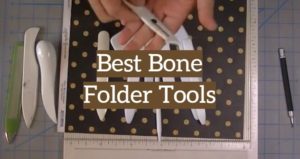
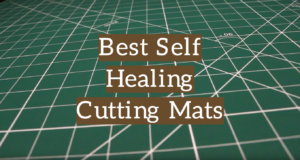
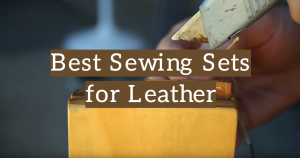


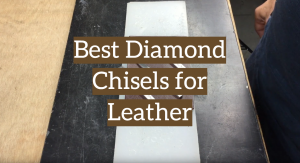
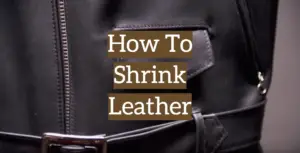
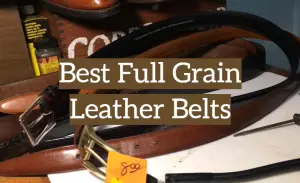

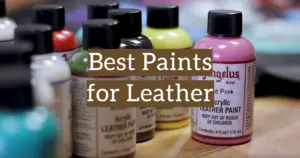




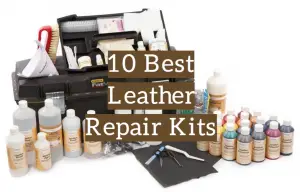
A well-made round knife for leather is not an option. It is a necessity. You want to be sure to buy a good one – you’ll thank yourself later.
Hello, David! Thanks for your comment.
Leather knives are the only way to cut leather perfectly. It’s been a struggle to find a knife that works well; however, the best option for me is the Weaver Leather Knife. I looked more into it and it’s a perfect fit.
Hello, Ramon! It’s a good choice.
The round knife is an absolutely splendid and useful leather-work tool, but perhaps the most dangerous item in my workshop. I have been putting razor edges on all sorts of tools for as long as I can remember, but the only serious cut I ever got was from a round knife. The danger comes, I think, from the fact that the edge is in that huge arc, and sharp edges face all sorts of directions; most other tools’ edges point in one direction, so it’s easier to keep your hands behind the edge at all times instinctively IMO, you have to learn this tool individually and always treat it as a special case requiring special handling and special care, no matter how familiar you are with straight knives, axes, chisels and other edged tools.
That cut cost me7 hrs in the accident & emergency dept., 6 stitches, and tetanus boost, a course of anti-biotics, and three follow-up trips to my GP. I could not use the hand for work for 2 1/2 wks following. Such accidents are very very boring and time-consuming; respect the round knife at all times!
Hello, Harry! Thanks for sharing your experience.